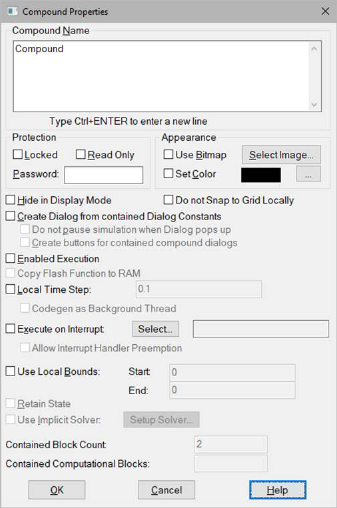
You make changes to the properties of a compound block through its Properties dialog. To access the Properties dialog, choose Edit > Block Properties and click the block, or select the compound block and press CTRL+right-click. If Display Mode is active, you access the Compound Properties dialog only with the Edit > Block Properties command.

Allow Interrupt Handler Preemption: Preempts the interrupt for higher priority interrupts.
Appearance: Applies a color or picture to a compound block.
Code Gen as Background Thread: Executes the contents of the compound block in a preemptible background thread. Activate Code Gen as Background Thread for operations that are not as time critical as the main control loop. This parameter is available only for Embed or Embed Personal.
Compound Name: Indicates the name of the compound block. If you want to change the name, avoid using the dot (.) character in the name; it is used to separate compound block names in the title bar.
Contained Block Count: Indicates the number of blocks in the compound block.
Contained Computational Blocks: Indicates the number of computational blocks in the compound block, when the compound block is triggered.
Copy FLASH function to RAM: Copies the FLASH function to RAM. On many embedded parts, code runs faster in RAM. If you are not generating code, there is no reason to activate this parameter.
Create buttons for contained compound Dialogs: Provides a mechanism to logically group and display user-defined parameter values in a compound block.
Create Dialog From Contained Dialog Constants: Manages user-defined parameter values in a compound block. When activated, the Create Dialog From Contained Dialog Constants also allows you to use buttons in your dialogs.
Do not pause simulation when Dialog pops up: Allows the simulation to continue if there are pop-up dialogs. This is particularly useful for real-time HIL simulations.
Do not Snap To Grid Locally: Overrides the Snap to Grid parameter in Edit > Preferences. When Do Not Snap to Grid Locally is activated, the blocks on the next lower level of the compound block do not automatically align to an invisible grid when you add or move them. To override automatic alignment of the top level compound block, use the Do Not Snap To Grid On The Top Level parameter in Edit > Preferences.
Enabled Execution: Conditionally executes a compound block using a Boolean trigger that appears as a red ball attached to the input side of the compound block.
Execute on Interrupt: Executes all blocks inside the compound block when the interrupt occurs. Interrupts correspond to hardware interrupts on the selected target. When Execute on Interrupt is activated, the compound block is displayed with red diagonal lines.
To preempt the interrupt for higher priority interrupts, activate Allow Interrupt Handler Preemption.
To allow proper operation of time-sensitive blocks in the compound block when you know the rate at which the interrupts occur, enter the rate Local Time Step and enable the parameter.
This parameter is available only if you are running Embed or Embed Personal.
Hide in Display Mode: Hides the block when Display Mode is activated.
Local Time Step: Specifies the time step for the subsystem. Together, Local Time Step and Use Local Bounds provide additional control over multi-rate simulation.
When Local Time Step is activated, the compound block is displayed with green diagonal lines, unless Execute on Interrupt or Use Local Bounds is also activated; in this case, the compound block is displayed with either red or blue diagonal lines, respectively.
If you have also activated Execute on Interrupts, then Local Time Step is only used to specify the interval between interrupts.
Protection: Applies protection to the block.
Use Implicit Solver: Activates the Implicit Solver for the compound block.
Use Local Bounds: Enable use of Local Time Step and local bounds to perform multiple iterations of all blocks contained within the compound block. For each execution of the compound block, the contained blocks are executed through the local bounds range. The total iteration count is (localEnd-localStart)/localStep. You can specify the local bounds and step as a constant or variable. It is possible to use nested local bounded compounds to give the effect of nested do loops. If you want an integral iteration count, set Local Time Step to 1 and use a ramp block inside the compound block to produce the iteration count. Plots contained within the local bounds compound will plot the entire local range for each execution of the containing compound. Using the break block allows an early exit from the local bounds iteration.
When Use Local Bounds is activated, the compound block is displayed with blue diagonal lines, unless Execute on Interrupt is also activated; in this case, the compound block is displayed with red diagonal lines.